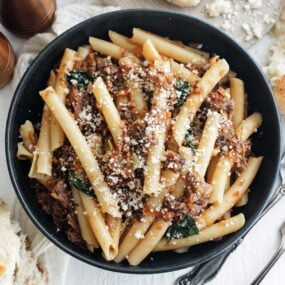

Pasta all Genovese
This Pasta alla Genovese, or Genovese Sauce, is simmered with beef, pancetta, caramelized onions, and wine before being tossed with pasta.
Ingredients
- 2 pounds beef shanks
- 2 pounds chuck roast, cut into 2” cubes
- 4 ounces medium-diced pancetta
- 6 large julienne yellow onions, about 5 pounds
- 2 peeled and finely minced carrots
- 2 finely minced ribs of celery
- 2 tablespoons tomato paste
- 6 to 8 sprigs of fresh thyme
- 15 to 20 torn basil leaves
- 10 to 12 hand-crushed cherry tomatoes
- 2 cups dry white wine
- 1 cup beef stock
- coarse salt and freshly cracked pepper to taste
- Finely grated Parmigiano Reggiano for garnish
- 1 pound long ziti broken or rigatoni
Instructions
- Pat dry the meat on all sides on a sheet tray or platter. Next, season well with salt and pepper. Briefly set to the side. For a deeper Maillard crust, you can also place the seasoned meat on a rack and leave it uncovered in the fridge for up to 24 hours.
- Add the pancetta to a large rondeau or Dutch oven pot over low to medium heat and cook for 5 to 7 minutes or until crispy and the fat is rendered. Set the lardons to the side.
- Turn the heat high and untouched; sear the beef for 3 to 4 minutes. Flip it over and turn the heat to medium. Cook for 6 to 8 minutes or until well-browned. Once I flip it, is when I prep the onions.
- Once browned, set the beef to the side. Add half the julienne onions, season with salt, and sauté over medium heat for 10 minutes. Then, turn the heat low and cook for 20 minutes while occasionally stirring until well-browned.
- Mix the carrots and celery and cook over medium heat for 10 minutes.
- Stir in the tomato paste and cook for 3 to 4 minutes or pince. The tomato paste should be a rust color.
- Add the beef, cooked pancetta, thyme, 10 to 12 torn basil leaves, cherry tomatoes, and white wine back in and cook until there is maybe just ½ cup of liquid left. This takes about 5 to 6 minutes.
- Cover everything with the remaining julienne onions and beef stock, season with salt and pepper, and stir to combine.
- Place a lid on the pot and cook it over low heat for 3 hours. Stir it every 30 to 45 minutes. Then, remove the lid and cook it for 1 hour. If it looks dry, you may need to add more beef stock.
- Break up the beef so that it shreds apart and incorporates into the sauce. Adjust the seasonings with salt and pepper.
- Next, boil the pasta in a large pot of salted water for 75% of the recommended cook time.
- Strain it and add it to a large saucier pan along with 1 cup of the pasta water, plenty of the Genovese sauce, grated Parmigiano Reggiano, and the remaining basil leaves. Cook over low heat to finish cooking the pasta. The flavor will be better as the sauce flavors marry into the pasta.
Notes
It’s essential to cut the beef shanks and chuck roast into 2-inch cubes to help them fit in the pot to sear evenly. That caramelized Maillard crust around the beef is key to locking in their flavor and juices.
Dry brine the beef: You can begin this recipe immediately after seasoning the meat; leaving it to dry brine in the fridge for up to 24 hours will make the pieces much more flavorful and give them a better chance of developing a golden brown crust around the outside.
“Pince” the tomato paste for up to 5 minutes: “Pince” is a culinary term for caramelizing tomato paste in a hot pan until it becomes fragrant and takes on a darker rust-like color. If you skip this step, the tomato paste will taste tinny, and your sauce will lack depth.
Don’t overcook the pasta: I recommend boiling the pasta until it’s just underdone (a little less than al dente). Once it’s combined with the sauce in the skillet, the noodles will soften and finish cooking.
Make-Ahead: Genovese sauce gets even better as it sits. I recommend making a batch at least 1 day in advance. If serving immediately, the sauce can be kept warm in the covered pot for about 2 hours over low heat. Then toss it with freshly cooked pasta.
How to Store: Transfer it to a container and store it in the refrigerator for up to 5 days. It also freezes well for up to 3 months. Allow the leftovers to thaw in the fridge overnight before serving.
How to Reheat: Warm as much Genovese sauce as you eat in a medium pot over low heat until warmed. Toss it with freshly cooked pasta before serving.
Nutrition
Calories: 1325kcalCarbohydrates: 111gProtein: 96gFat: 45gSaturated Fat: 17gPolyunsaturated Fat: 5gMonounsaturated Fat: 21gTrans Fat: 2gCholesterol: 228mgSodium: 700mgPotassium: 2363mgFiber: 8gSugar: 15gVitamin A: 5709IUVitamin C: 29mgCalcium: 179mgIron: 11mg